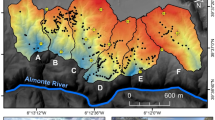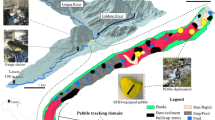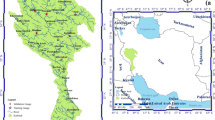Abstract
Assessment of the spatial distribution of potential pathways of sediment transport and the degree of linkage between sediment sources and the channel network within a watershed represents a valuable analysis for informing management decisions on sediment yield and transfer. Given the limitations of conventional methods for determining index of sediment connectivity (IC), there is a need to provide a flexible and efficient approach with the ability to apply different factors. In this regard, five decision tree-based machine learning models: M5 prime (M5P), random tree (RT), random forest (RF), alternating model tree (AMT), and reduced error pruning tree (REPT) were tested using geomorphic and climatic factors. Two databases were constructed with 200 and 1600 classes at 50 watersheds in Queensland, Australia. In these models, IC was assessed as an output parameter and six attributes that affect IC were assigned as input parameters (i.e., elevation, slope, area, length of stream channel, normalized difference vegetation index, and rainfall). Statistical validation and comparison of model predictions with calculated IC values based on the approach of Borselli et al. (Catena 75:268–277, 2008) were performed. Based on the statistical criteria, the RF model produced the most robust estimations of IC compared to other models and performed very well for IC modelling, especially in smaller subsections of watersheds. Accordingly, these findings can play an effective role for implementing watershed management and soil and water resources management measures.









Similar content being viewed by others
Data Availability
The corresponding author can provide the data that back up the study’s conclusions upon request.
References
Aghamolaei Z, Hessami-Kermani M-R (2023) Developing a new artificial intelligence framework to estimate the thalweg of rivers. Water Resour Manag 1–25. https://doi.org/10.1007/s11269-023-03632-8
Al-Mukhtar M (2019) Random forest, support vector machine, and neural networks to modelling suspended sediment in Tigris River-Baghdad. Environ Monit Assess 191:673
Aldous D (1993) The continuum random tree III. Ann Probab 248–289
Aldous D (1991) The continuum random tree. II. An overview. Stoch Anal 167:23–70
Ali MM, Paul BK, Ahmed K et al (2021) Heart disease prediction using supervised machine learning algorithms: performance analysis and comparison. Comput Biol Med 136
Asadi H, Dastorani MT, Khosravi K, Sidle RC (2022) Applying the C-Factor of the RUSLE Model to improve the prediction of suspended sediment concentration using Smart Data-Driven models. Water 14
Asadi H, Dastorani MT, Sidle RC (2023a) Estimating index of sediment connectivity using a smart data-driven model. J Hydrol 620
Asadi S, Tartibian B, Moni MA (2023b) Determination of optimum intensity and duration of exercise based on the immune system response using a machine-learning model. Sci Rep 13:8207
Asadi H, Dastorani MT, Sidle RC, Shahedi K (2021) Improving Flow Discharge-suspended sediment relations: Intelligent algorithms versus data separation. Water 13
Ayele GT, Teshale EZ, Yu B, Rutherfurd ID, Jeong J (2017) Stream flow and sediment yield prediction for watershed prioritization in the Upper Blue Nile River Basin, Ethiopia. Water 9(782). https://doi.org/10.3390/w9100782
Biau G, Scornet E (2016) A random forest guided tour. TEST 25:197–227
Borselli L, Cassi P, Torri D (2008) Prolegomena to sediment and flow connectivity in the landscape: a GIS and field numerical assessment. Catena 75:268–277
Bracken LJ, Turnbull L, Wainwright J, Bogaart P (2015) Sediment connectivity: a framework for understanding sediment transfer at multiple scales. Earth Surf Process Landforms 40:177–188
Breiman L (2001) Random forests. Mach Learn 45:5–32
Bui DT, Khosravi K, Tiefenbacher J et al (2020) Improving prediction of water quality indices using novel hybrid machine-learning algorithms. Sci Total Environ 721
Cammeraat LH (2002) A review of two strongly contrasting geomorphological systems within the context of scale. Earth Surf Process Landforms 27:1201–1222
Cavalli M, Tarolli P, Dalla Fontana G, Marchi L (2016) Multi-temporal analysis of sediment source areas and sediment connectivity in the Rio Cordon catchment (Dolomites). Rend Online Soc Geol Ital 39:27–30
Cavalli M, Trevisani S, Comiti F, Marchi L (2013) Geomorphometric assessment of spatial sediment connectivity in small Alpine catchments. Geomorphology 188:31–41
Chia MY, Koo CH, Huang YF, Di Chan W, Pang JY (2023) Artificial intelligence generated synthetic datasets as the remedy for data scarcity in water quality index estimation. Water Resour Manag 37(15):6183–6198
Croke J, Fryirs K, Thompson C (2013) Channel–floodplain connectivity during an extreme flood event: implications for sediment erosion, deposition, and delivery. Earth Surf Process Landforms 38:1444–1456
Croke J, Mockler S, Fogarty P, Takken I (2005) Sediment concentration changes in runoff pathways from a forest road network and the resultant spatial pattern of catchment connectivity. Geomorphology 68:257–268
De Vente J, Poesen J (2005) Predicting soil erosion and sediment yield at the basin scale: scale issues and semi-quantitative models. Earth Sci Rev 71:95–125
Ding B, Yang K, Qin J et al (2014) The dependence of precipitation types on surface elevation and meteorological conditions and its parameterization. J Hydrol 513:154–163
Durigon VL, Carvalho DF, Antunes MAH et al (2014) NDVI time series for monitoring RUSLE cover management factor in a tropical watershed. Int J Remote Sens 35:441–453
Fijani E, Khosravi K (2023) Hybrid iterative and tree-based machine learning algorithms for lake water level forecasting. Water Resour Manag 37(14):5431–5457
Freund Y, Mason L (1999) The alternating decision tree learning algorithm. In icml (Vol. 99, pp 124–133)
Fressard M, Cossart E (2019) A graph theory tool for assessing structural sediment connectivity: development and application in the Mercurey vineyards (France). Sci Total Environ 651:2566–2584
Fryirs K (2013) Dis) Connectivity in catchment sediment cascades: a fresh look at the sediment delivery problem. Earth Surf Process Landforms 38:30–46
Galathiya AS, Ganatra AP, Bhensdadia CK (2012) Improved decision tree induction algorithm with feature selection, cross validation, model complexity and reduced error pruning. Int J Comput Sci Inf Technol 3:3427–3431
Garcia-Martino AR, Warner GS, Scatena FN, Civco DL (1996) Rainfall, runoff and elevation relationships in the Luquillo Mountains of Puerto Rico. Caribb J Sci 32:413–424
Gay A, Cerdan O, Mardhel V, Desmet M (2016) Application of an index of sediment connectivity in a lowland area. J Soils Sediments 16:280–293
Gelete G (2023) Hybrid extreme gradient boosting and nonlinear ensemble models for suspended sediment load prediction in an agricultural catchment. Water Resour Manage Please provide complete bibliographic details of this reference. Water Resour Manag 1–29. https://doi.org/10.1007/s11269-023-03629-3
Ghorbani MA, Deo RC, Kim S et al (2020) Development and evaluation of the cascade correlation neural network and the random forest models for river stage and river flow prediction in Australia. Soft Comput 24:12079–12090
González-Romero J, López‐Vicente M, Gómez‐Sánchez E et al (2021) Post‐fire management effects on sediment (dis) connectivity in Mediterranean forest ecosystems: Channel and catchment response. Earth Surf Process Landforms 46:2710–2727
Heckmann T, Schwanghart W (2013) Geomorphic coupling and sediment connectivity in an alpine catchment—exploring sediment cascades using graph theory. Geomorphology 182:89–103
Heckmann T, Vericat D (2018) Computing spatially distributed sediment delivery ratios: inferring functional sediment connectivity from repeat high-resolution digital elevation models. Earth Surf Process Landforms 43:1547–1554
Heddam S, Kisi O (2018) Modelling daily dissolved oxygen concentration using least square support vector machine, multivariate adaptive regression splines and M5 model tree. J Hydrol 559:499–509
Jahanshahi A, Booij MJ (2023) Exploring controls on rainfall–runoff events: spatial dynamics of event runoff coefficients in Iran. Hydrol Sci J 68:954–966
Jahanshahi A, Ghazanchaei Z, Navari M et al (2022) Dependence of rainfall-runoff model transferability on climate conditions in Iran. Hydrol Sci J 67:564–587
Jarihani AA, Callow JN, McVicar TR et al (2015) Satellite-derived Digital Elevation Model (DEM) selection, preparation and correction for hydrodynamic modelling in large, low-gradient and data-sparse catchments. J Hydrol 524:489–506
Jayanthi SK, Sasikala S (2013) Reptree classifier for identifying link spam in web search engines. IJSC 3:498–505
Jiménez F, Sánchez G, Palma J et al (2021) Multivariate feature ranking of gene expression data. arXiv Prepr arXiv211102357
Kalantari Z, Ferreira CSS, Koutsouris AJ et al (2019) Assessing flood probability for transportation infrastructure based on catchment characteristics, sediment connectivity and remotely sensed soil moisture. Sci Total Environ 661:393–406
Keesstra S, Nunes JP, Saco P et al (2018) The way forward: can connectivity be useful to design better measuring and modelling schemes for water and sediment dynamics? Sci Total Environ 644:1557–1572
Khosravi K, Cooper JR, Daggupati P et al (2020) Bedload transport rate prediction: application of novel hybrid data mining techniques. J Hydrol 585
Khozani ZS, Khosravi K, Pham BT et al (2019) Determination of compound channel apparent shear stress: application of novel data mining models. J Hydroinformatics 21:798–811
Koci J, Sidle RC, Jarihani B, Cashman MJ (2020) Linking hydrological connectivity to gully erosion in savanna rangelands tributary to the great barrier reef using structure-from‐motion photogrammetry. L Degrad Dev 31:20–36
LaValle S (1998) Rapidly-exploring random trees: a new tool for path planning. Res Rep 9811
López-Vicente M, González-Romero J, Lucas-Borja ME (2020) Forest fire effects on sediment connectivity in headwater sub-catchments: evaluation of indices performance. Sci Total Environ 732
Marchamalo M, Hooke JM, Sandercock PJ (2016) Flow and sediment connectivity in semi-arid landscapes in SE Spain: patterns and controls. L Degrad Dev 27:1032–1044
Martini L, Baggio T, Torresani L et al (2022) R_IC: a novel and versatile implementation of the index of connectivity in R. Environ Model Softw 155
Masselink RJH, Keesstra SD, Temme AJAM et al (2016) Modelling discharge and sediment yield at catchment scale using connectivity components. L Degrad Dev 27:933–945
Mohamed WNHW, Salleh MNM, Omar AH (2012) A comparative study of reduced error pruning method in decision tree algorithms. In: 2012 IEEE International conference on control system, computing and engineering. IEEE, pp 392–397
Moriasi DN, Arnold JG, Van Liew MW, Bingner RL, Harmel RD, Veith TL (2007) Model evaluation guidelines for systematic quantification of accuracy in watershed simulations. Trans. ASABE 50:885–900
Mutanga O, Adam E, Cho MA (2012) High density biomass estimation for wetland vegetation using WorldView-2 imagery and random forest regression algorithm. Int J Appl Earth Obs Geoinf 18:399–406
Najafi S, Sadeghi SH, Heckmann T (2021) Analysis of sediment accessibility and availability concepts based on sediment connectivity throughout a watershed. L Degrad Dev 32:3023–3044
Parsons AJ, Bracken L, Poeppl RE et al (2015) Introduction to special issue on connectivity in water and sediment dynamics. Earth Surf Process Landforms 40:1275–1277
Phillips JD, Schwanghart W, Heckmann T (2015) Graph theory in the geosciences. Earth Sci Rev 143:147–160
Quinlan JR (1992) Learning with continuous classes. In: 5th Australian joint conference on artificial intelligence. World Scientific pp 343–348
Quinlan JR (1987) Simplifying decision trees. Int J Man Mach Stud 27:221–234
Renard KG (1997) Predicting soil erosion by water: a guide to conservation planning with the Revised Universal Soil Loss Equation (RUSLE). United States Government Printing
Senagi K, Jouandeau N (2022) Parallel construction of Random Forest on GPU. J Supercomput 78:10480–10500
Sichingabula HM (1998) Factors controlling variations in suspended sediment concentration for single-valued sediment rating curves, Fraser River, British Columbia, Canada. Hydrol Process 12:1869–1894
Tehrany MS, Pradhan B, Jebur MN (2013) Spatial prediction of flood susceptible areas using rule based decision tree (DT) and a novel ensemble bivariate and multivariate statistical models in GIS. J Hydrol 504:69–79
Tiranti D, Crema S, Cavalli M, Deangeli C (2018) An integrated study to evaluate debris flow hazard in alpine environment. Front Earth Sci 6:60
Tehrany MS, Pradhan B, Jebur MN (2014) Flood susceptibility mapping using a novel ensemble weights-of-evidence and support vector machine models in GIS. J Hydrol 512:332–343
Turnbull L, Hütt M-T, Ioannides AA et al (2018) Connectivity and complex systems: learning from a multi-disciplinary perspective. Appl Netw Sci 3:1–49
Wang Y, Witten IH (1997) April. Inducing model trees for continuous classes. In: Proceedings of the Ninth European Conference on Machine Learning 128–137
Wischmeier WH, Smith DD (1978) Predicting rainfall erosion losses: a guide to conservation planning. Department of Agriculture, Science and Education Administration
Wohl E, Brierley G, Cadol D et al (2019) Connectivity as an emergent property of geomorphic systems. Earth Surf Process Landforms 44:4–26
Yousefi S, Pourghasemi HR, Avand M et al (2021) Assessment of land degradation using machine-learning techniques: a case of declining rangelands. L Degrad Dev 32:1452–1466
Youssef AM, Pradhan B, Pourghasemi HR, Abdullahi S (2015) Landslide susceptibility assessment at Wadi Jawrah Basin, Jizan region, Saudi Arabia using two bivariate models in GIS. Geosci J 19:449–469
Zhan C, Gan A, Hadi M (2011) Prediction of lane clearance time of freeway incidents using the M5P tree algorithm. IEEE Trans Intell Transp Syst 12:1549–1557
Zhao, C., Liu, C., Li, W., Tang, Y., Yang, F., Xu, Y., ... & Hu, C. (2023). Simulation of urban flood process based on a hybrid LSTM-SWMM model. Water Resour Manag 37(13):5171–5187
Ziegler AD, Benner SG, Tantasirin C et al (2014) Turbidity-based sediment monitoring in northern Thailand: hysteresis, variability, and uncertainty. J Hydrol 519:2020–2039
Zounemat-Kermani M, Kis¸i ¨O, Adamowski J, Ramezani-Charmahineh A (2016) Evaluation of data driven models for river suspended sediment concentration modeling. J Hydrol 535:457–472
Funding
This work was supported by the Ferdowsi University of Mashhad (grant number FUM-64635).
Author information
Authors and Affiliations
Contributions
Haniyeh Asadi: Conceptualization, Methodology, Investigation, Formal analysis, Writing – original draft. Mohammad T. Dastorani: Methodology, Supervision, Writing – review & editing. Roy C. Sidle: Methodology, Writing – review & editing. Afshin Jahanshahi: Formal analysis, Writing – review & editing.
Corresponding author
Ethics declarations
Ethical Approval
All authors read and approved the final manuscript.
Competing Interests
The authors have no relevant financial or non-financial interests to disclose.
Additional information
Publisher’s Note
Springer Nature remains neutral with regard to jurisdictional claims in published maps and institutional affiliations.
Rights and permissions
Springer Nature or its licensor (e.g. a society or other partner) holds exclusive rights to this article under a publishing agreement with the author(s) or other rightsholder(s); author self-archiving of the accepted manuscript version of this article is solely governed by the terms of such publishing agreement and applicable law.
About this article
Cite this article
Asadi, H., Dastorani, M.T., Sidle, R.C. et al. A Comparative Assessment of Decision Tree Algorithms for Index of Sediment Connectivity Modelling. Water Resour Manage 38, 2293–2313 (2024). https://doi.org/10.1007/s11269-024-03760-9
Received:
Accepted:
Published:
Issue Date:
DOI: https://doi.org/10.1007/s11269-024-03760-9




